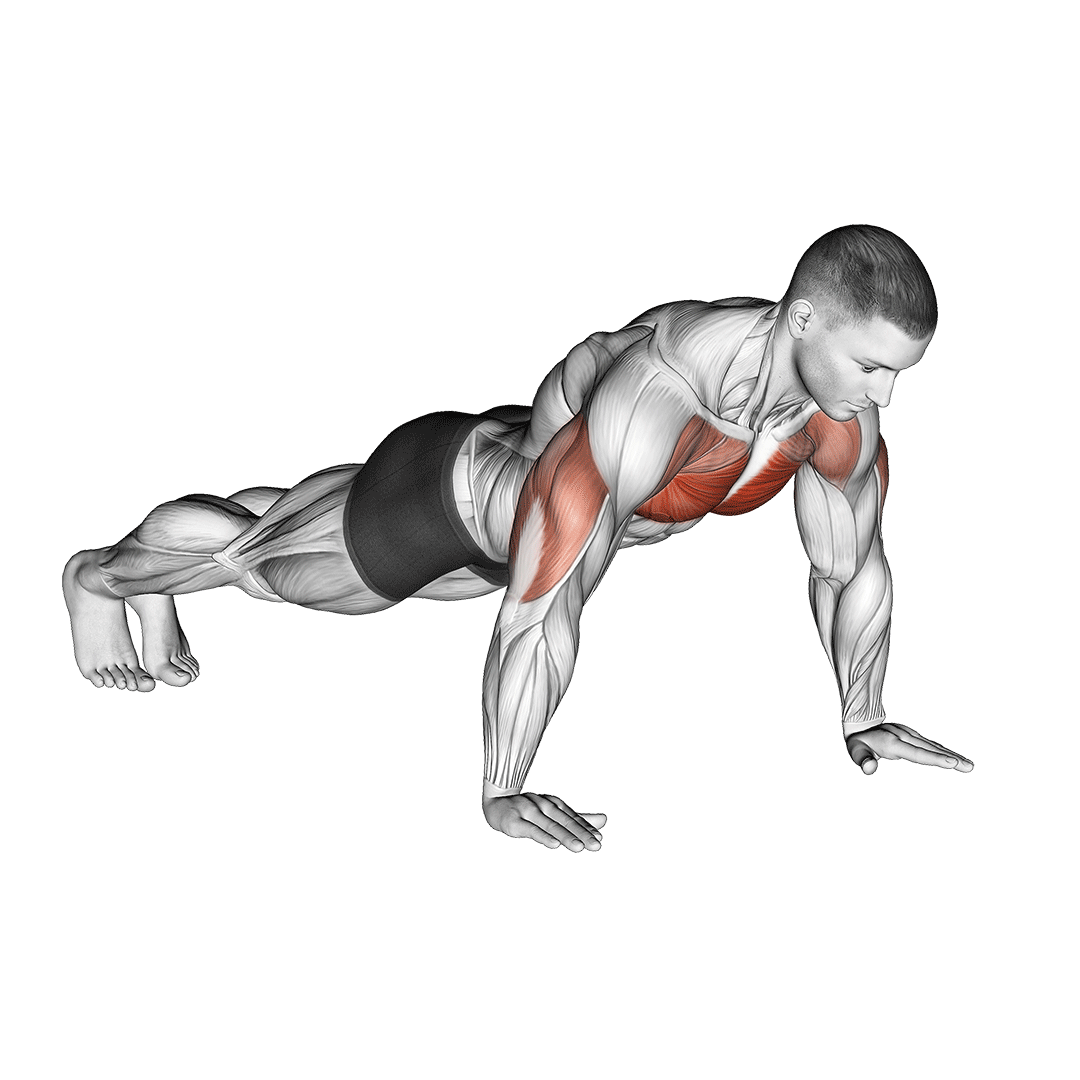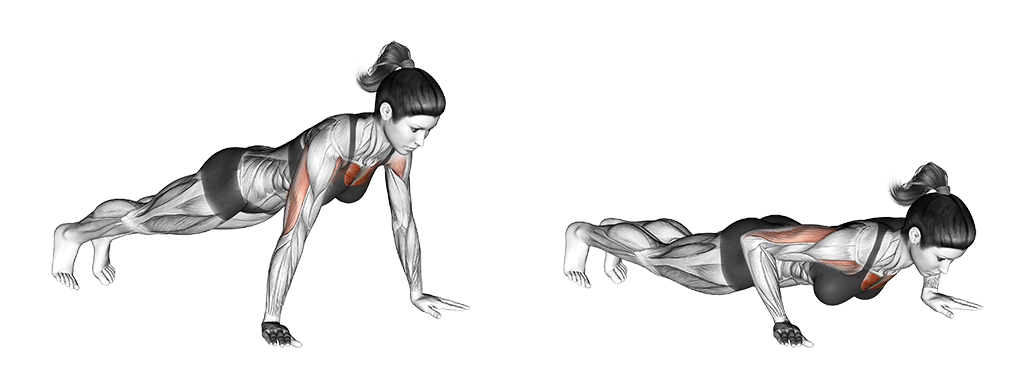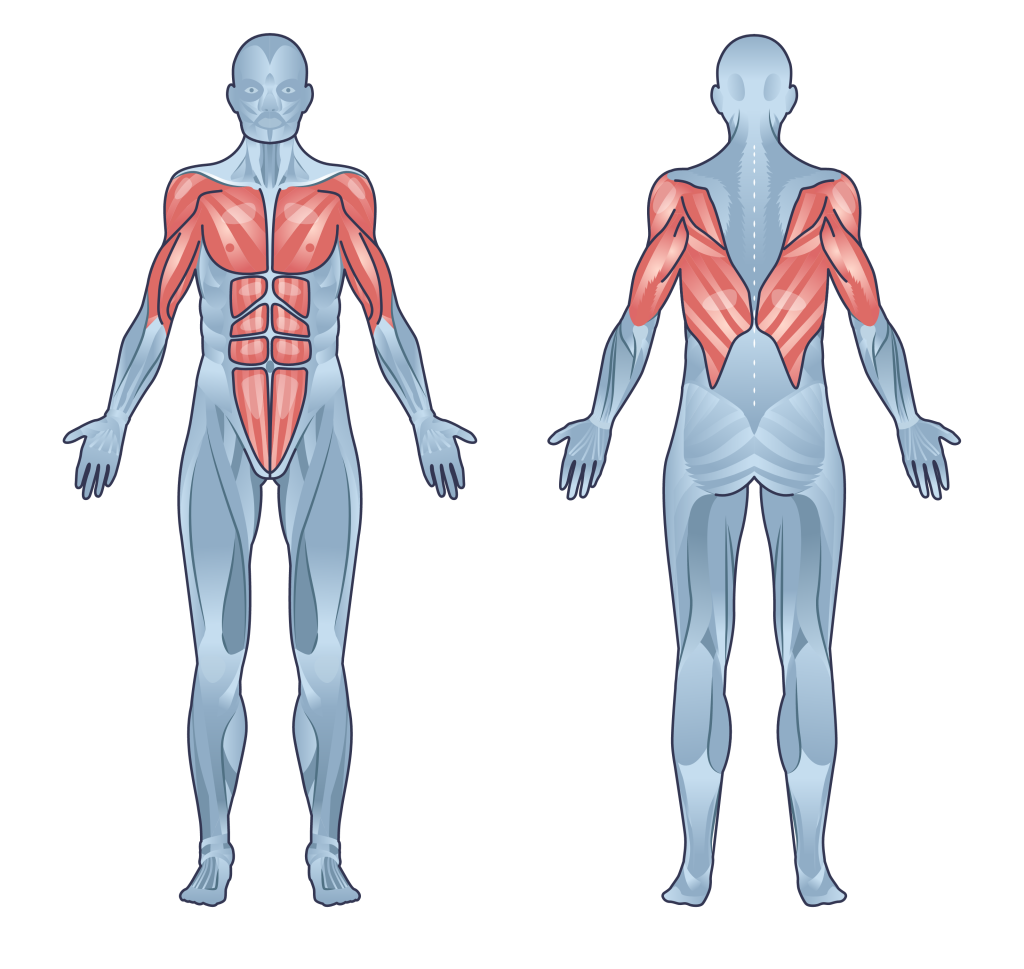How Many Push Ups a Day to Build Muscle?
First things first - if you are performing any resistance exercise on a daily basis, it is best to stop doing so immediately; This includes push-ups as well.
Resistance training exercises like the push-up, squat or pull-up create micro-tears in the fibers of the skeletal muscles. When subjected to the repeated stress of resistance training without a break, these tears become too numerous to reasonably recover from overnight, leading to diminishing returns, overtraining and eventual injury.
So - when the question is "how many push-ups a day are needed to build muscle?" The answer is zero.
Instead, it is best to perform 3-5 sets of push-ups on an alternating-day basis, with additional care taken to ensure the body is allowed to recover with time off and a proper diet.
What are Push-Ups?
Push-ups are a multi-joint compound exercise traditionally performed with only the body’s own weight as a source of resistance.
While this naturally translates to a low risk of injury, it also means that many repetitions will need to be performed in order to see results - repetitions that involve repeated movements of the same joint, leading to overuse injuries and irritation if not accounted for.

Push-ups are favored by at-home exercisers due to the lack of required equipment and relative simplicity in which they build the muscles of the upper body.
What Muscles are Built by Push-Ups?
Push-ups are used to build the pectoral (or chest muscles), the front section of the deltoid (or shoulder) muscles, and the triceps brachii of the upper arms.
They can also strengthen muscles like the serratus, abs and forearms - although not to the same extent as the three aforementioned muscle groups.
How to do Push-Ups Properly
To perform a repetition of push-ups, exercisers will enter a plank position on the floor, keeping their legs fully extended and their hands parallel to the shoulders.

Then, bending at the elbows, the exerciser will lower their torso towards the floor, stopping once the chest is within several inches of touching the ground.
Pausing for a moment, they will then push through the palms of their hands, extending the elbows and returning to the original plank stance once more - thereby completing the repetition.
How do Push-Ups Build Muscle Mass?
As was touched upon at the start of this article, resistance training produces micro-tears in the fibers of skeletal musculature. Though this may sound like a negative thing, it is actually quite important - as the body’s muscles will not grow without first being damaged in such a manner.
Push-ups create this effect by lengthening and shortening the muscles of the chest, arms and shoulders as they work against resistance and tension. Over the course of multiple repetitions, this physiological stress causes the aforementioned micro-tears of the muscles to occur.

During periods of recovery, the body will “over-heal” these tears, resulting in larger muscles or what is known as “muscular hypertrophy”.
How Muscular Hypertrophy Occurs From Push-Ups
Contrary to what is occasionally reported, muscular hypertrophy doesn’t produce more muscle fibers. Instead, it simply increases the sectional size of each individual component of a skeletal muscle group.
This effect is achieved by first damaging the fibers of a skeletal muscle through a combination of dynamic contraction, applied resistance, time under tension and a mixture of both concentric and eccentric movement - all of which occur during a repetition of the push-up.
Because of the fact that push-ups place the triceps, deltoids and pectorals in a position where they must resist the weight of the body (and gravity) as they move through their natural ranges of motion, the aforementioned micro-tears occur.
In response, the body increases inducible hormone production and diverts and synthesizes more resources towards these damaged skeletal muscles, resulting in muscular hypertrophy as the fibers are repaired larger and stronger than they were before.
How Does Muscular Hypertrophy Relate to Doing Push-Ups Everyday?
As one may note, this period of hormone production and muscular protein synthesis primarily occurs after training is over - meaning that it is during periods of recovery that our muscles grow, not during the actual workout itself.
This is the reason why doing push-ups everyday is a poor decision. You will not be growing your muscles every day, only damaging them, and allotting no time with which your body may heal.
So - How Many Push-Ups Should You Do for Building Muscle?
Like other aspects of proper training programming, the answer will depend on who is performing the push-ups, and their current level of training experience.
Keep in mind that these numbers assume you are not training every single day, as doing so will be counterintuitive to muscle growth.
For Novices
Novice exercisers will see the best results by training to near-failure with each set, meaning that if you can perform ten repetitions in one go, it is best to perform nine for each set - with up to five sets per workout.
A good start for novice exercisers would be to attempt to perform 3-4 sets of 6-10 repetitions, going higher as needed.
If the exerciser is unable to perform push-ups for as many repetitions, they may wish to instead do knee-ups or any other low-intensity alternative to the push-up.
For Intermediate and Advanced Exercisers
Finding a specific push-up training volume for intermediate and advanced exercisers is somewhat more complicated, as the body begins to slow in terms of physical development after a certain amount of muscle has already been gained.
Intermediate exercisers will often find that a good starting point would be 3-4 sets of 15-25 repetitions each is sufficient - although throwing in an AMRAP (as many reps as possible) set may help squeeze out more hypertrophy, if so needed.
Advanced exercisers, on the other hand, may see better results by foregoing regular push-ups entirely. Instead, they may wish to substitute with more complex and intense push-up variations like the weighted push-up or clapping push-up.
Structuring a Push-Up Training Program for Mass
Having covered how many push-ups to do and whether you should do them every day or not - another aspect to consider is how to go about programming these workout sessions.
Volume and Sets
Generally, exercisers will want to perform multiple high volume sets that do not reach the point of total failure. This will vary between exercisers, but is generally their maximum amount of push-ups with 2-3 repetitions subtracted.
In terms of sets, exercisers will see the best results by staying under 5-6 sets per workout, as any higher may be too much volume for their joints to handle.
Structuring Workout Sessions
Push-ups are not meant to be the sole exercise performed within a workout, and a training program should reflect as such.
Depending on the training split and the exerciser’s level of experience, push-ups may take the role of a primary compound exercise alongside other movements like tricep dips and bodyweight dips - or they may also act as an accessory movement to weighted exercises like the bench press instead.
As a general rule, the more intense an exercise is, the sooner it should be performed in a workout. This often means compound exercises come first, with isolation exercises acting more as a supplementary movement instead.
How to Program Recovery Time
As was mentioned earlier in this article, taking at least 24 hours or one day of rest between workouts of the same muscles is helpful - but, in some cases, insufficient.
While it varies between individuals, the majority of studies show that skeletal muscles can take up to 48 hours to recover from rigorous resistance exercise - meaning that taking only one day between push-up workouts might not be enough.
So - how do you go about getting enough recovery time? The simplest way is to tie your workouts to certain days of the week.
Structure 3 separate days of the week with workouts involving push-ups, each of which is followed by a day of recovery - and with two days of recovery after the last workout.
To illustrate, one may choose to perform push-ups Monday-Wednesday-Friday, while taking Tuesday-Thursday and the weekends off.
One Other Factor to Consider for Building Muscle with Push-Ups
Apart from proper programming and form, push-ups will build the most muscle when performed alongside sufficient protein intake and a caloric surplus. In fact, performing any sort of exercise with a poor diet is unlikely to result in muscular hypertrophy - defeating the entire purpose.
Consuming anywhere between 1.6 to 2 grams of protein per kilogram of body weight is considered sufficient, as well as between 250 and 500 calories over the body’s daily energy expenditure.
Frequently Asked Questions (FAQ)
Will I Gain Muscle if I Do Push-Ups Everyday?
Yes - but it is also likely that you would gain more muscle if you take at least 24 hours off between workout sessions. While some muscular hypertrophy can occur from training every single day, allowing the body to recover between training days can maximize the amount that occurs.
Can You Build a Big Chest With Push-Ups?
Yes - push-ups are excellent for building both strength and size in the pectoral muscles.
With proper programming and the right kind of diet, any exerciser can pack on pounds of muscle mass with bodyweight exercises alone.
When is the Best Time to do Push-Ups?
The best time to perform push-ups will vary between individuals. Some exercisers may find that they perform better early in the day, whereas others may wish to instead perform late in the evening, even before bed in some cases.
Ideally, the best performance will come 1-2 hours after a carbohydrate-heavy meal, as the muscles will be fueled properly by the glycogen that is metabolized from said carbohydrates.
Final Thoughts
Now that you have a firmer understanding of how to structure push-up volume, it’s time to put your program into action.
Remember that - like all other exercises - performing the push-up is most effective when done with proper form. If you are unsure of how to go about doing so, seeking the advice of an athletic coach is the most effective way of getting hands-on answers to your questions.
References
1. McGlory C, Devries MC, Phillips SM. Skeletal muscle and resistance exercise training; the role of protein synthesis in recovery and remodeling. J Appl Physiol (1985). 2017 Mar 1;122(3):541-548. doi: 10.1152/japplphysiol.00613.2016. Epub 2016 Oct 14. PMID: 27742803; PMCID: PMC5401959.
2. Dhahbi, Wissem & Chaabene, Helmi & Chaouachi, Anis & Padulo, Johnny & Behm, David & Cochrane Wilkie, Jodie & Burnett, Angus & Chamari, Karim. (2018). Kinetic analysis of push-up exercises: a systematic review with practical recommendations. Sports Biomechanics. 21. 10.1080/14763141.2018.1512149.
